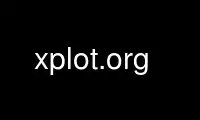
This is the command xplot.org that can be run in the OnWorks free hosting provider using one of our multiple free online workstations such as Ubuntu Online, Fedora Online, Windows online emulator or MAC OS online emulator
PROGRAM:
NAME
xplot.org — fast tool to graph and visualize lots of data
SYNOPSIS
xplot.org [-v] [-x] [-y] [-tile] [-mono] [-1] [-d display | -display display] [-d2 display]
file [files...]
DESCRIPTION
xplot.org is a fast visualization tool for examining multiple data sets in parallel plots.
It supports easy zoom-in and zoom-out capabilities, and synchronized views into multiple
data sets (with the -x, -y, and -tile options).
OPTIONS
-1 allows one to look at multiple data sets, one at a time. This changes the behavior of
click-right and shift-click-right from exiting and printing to cycling forward and backward
through the various plots.
-d display, -display display,
-d2 display, all select which display(s) on which to draw the graphs.
-mono causes the graph(s) to be drawn in black and white, with no use of color.
-tile allows one to look at multiple data sets in parallel. The plots will each consume
1/nth of the vertical space that would have been used with one plot. This works well if the
window manager refrains from wasting pixels with decorative tabs and respects the hints that
xplot.org provides.
-v prints the version number.
-x causes several graphs to be synchronized on the X-axis (zooming in one window zooms all
the others, with the same portion of the X-axis on display). The Y-axis of the other graphs
will be autoscaled to fit the data.
-y causes several graphs to be synchronized on the Y-axis (zooming in one window zooms all
the others, with the same portion of the Y-axis on display).
USE OF MOUSE BUTTONS
When running xplot.org, the mouse may be used to zoom in and out on data.
Dragging with the left mouse button depressed while inside the axes of the graph draws a
rubber-band box around the area to be replotted in the existing window.
Dragging with the left mouse button depressed while outside the axes (below the X-axis or to
the left of the Y-axis) selects the range of the axis to plot. In effect, this is like the
previous mechanism, but only zooming on one axis.
Dragging with the middle mouse button inside the axes pans the graph; the start-drag
position ends up being at the end-drag position. Dragging on the axes pans only in one
dimension.
Clicking the left mouse button zooms out to the previous view. One can zoom in multiple
times, then back up through each view. Panning locations are not saved.
Clicking the right mouse button exits the program.
Shift-clicking on the mouse buttons produces Postscript files with the same axis extents as
the current view. Shift-left produces a full-page view. Shift-middle produces a squarish
plot, and shift-right a plot such that three of them fit on a page of LaTeX.
PLOT LANGUAGE
There are several example files demo.0, demo.1, demo.2, etc., stored with the xplot.org
sources. demo.0 lists all the commands.
xplot.org demo.0
demonstrates xplot.org's capabilities.
USE WITH TCPDUMP
The command
tcpdump -tt -S ... > tcpdump.out
saves a tcpdump formatted output trace to tcpdump.out. The -tt and -S flags tell tcpdump to
print an unformatted timestamp and to use absolute TCP sequence numbers.
This trace can then be examined by being processed with tcpdump2xplot.
tcpdump -plot tcpdump.out
Use xplot.org online using onworks.net services
